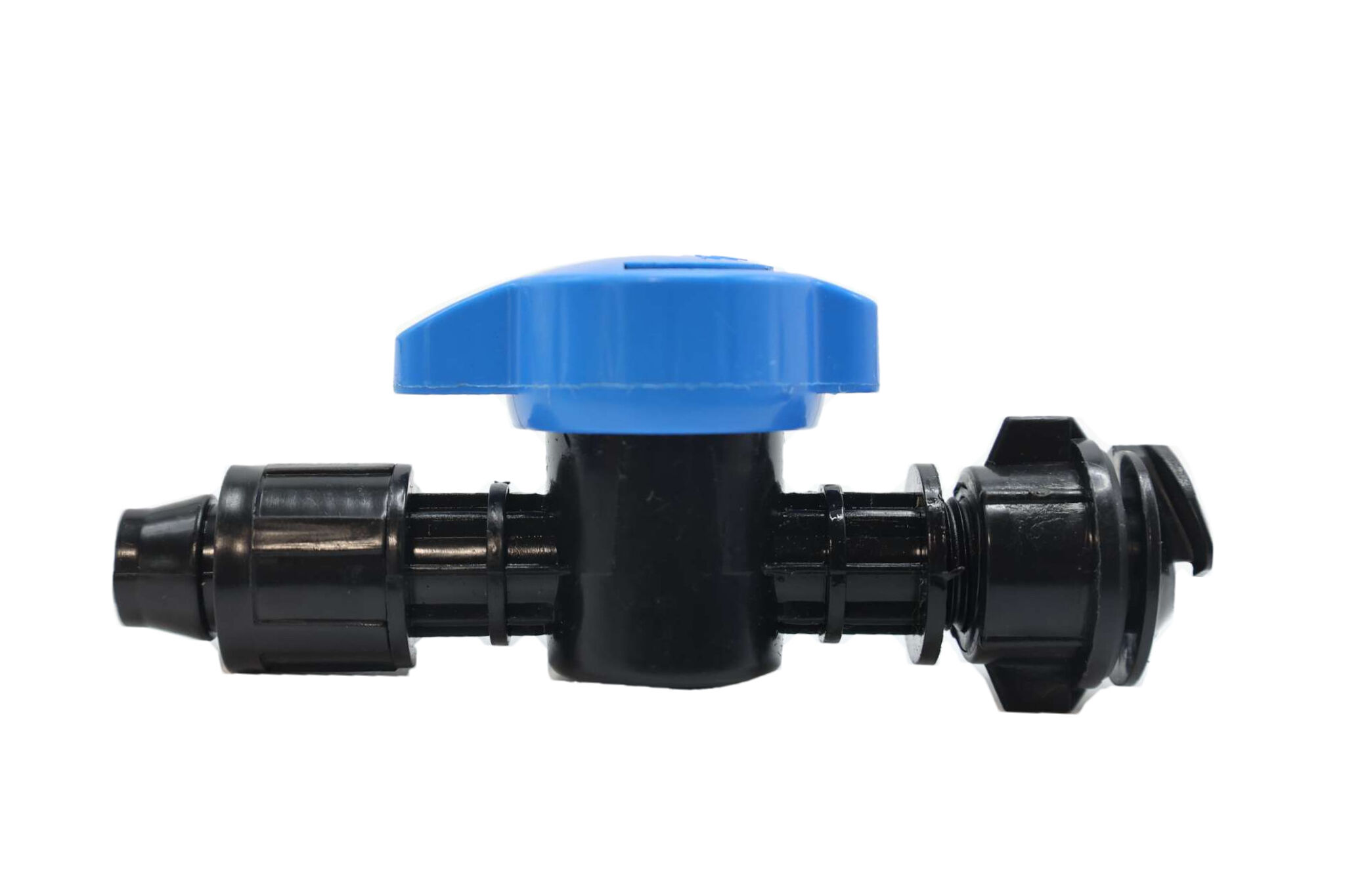Understanding the Circular Handle Bypass Valve and Its Role in Irrigation
What Is a Bypass Valve? Defining Core Functionality
Bypass valves help manage water flow and pressure in irrigation setups by sending extra water away from parts that could get damaged. They work differently from regular shut off valves since they actually serve as a kind of emergency backup when there's sudden pressure spikes in the pipes. Farmers find these valves really useful because they can fix problems in one part of their fields without turning everything else off. Take a situation where a drip line starts leaking somewhere out in the field. With a good bypass valve installed, farmers can quickly redirect water around the problem area, which cuts down on wasted water maybe even saving around 30% according to some studies published last year in Agricultural Engineering Journal. While these valves share some similarities with connector valves found in drip tape systems, what makes them special is how they focus on releasing pressure instead of just controlling different sections of the system.
How the Circular Handle Bypass Valve Differs from Standard Irrigation Valves
Circular handles bring both comfort and practical benefits when compared to those old fashioned lever operated valves that everyone has been using for decades. The problem with lever valves is they need quite a bit of muscle power just to open them properly, plus they don't really work well when only partially opened either. That's where circular handles shine though. They rotate all the way around 360 degrees which means operators can tweak settings precisely without breaking a sweat something that matters a lot when trying to keep pressure steady across variable speed pumps. According to some recent field tests published by the Irrigation Association last year, these circular designs cut down on valve stem wear by about half compared to their lever counterparts. This actually makes sense because less friction means components last much longer in places where valves get used constantly throughout the day.
Integration of the Circular Handle Bypass Valve in Sprinkler Valve Systems
Sprinkler systems get a real boost when circular handle bypass valves are added to them. These valves make things work better and are much easier to maintain over time. Because they're so small, installers can fit them into tight spots next to pressure regulators or right at pump discharge points where space is always an issue. Winterizing becomes a breeze too. Technicians just need to turn these valves and whole sections of the system will drain out within around 8 to 10 minutes, which cuts down on work time by about 40% compared to old fashioned ball valves. Another plus is how well they play with secondary pressure sensors. This makes them great for mixed systems where some parts are controlled manually while others run automatically.
Types of Bypass Valves and Advantages of the Circular Handle Design
Comparative Analysis of Bypass Valve Types in Modern Irrigation
There are basically three main types of bypass valves used in modern irrigation systems these days: gate valves, ball valves, and those with circular handles. Gate valves actually create much less friction when water flows through them compared to butterfly valves, around 15% less according to a study published in the Irrigation Tech Journal back in 2023. That makes them pretty good for isolating sections of the main pipeline. Ball valves work great for shutting off water completely in areas where there's a lot of flow going on, though they don't do so well when fine tuning the amount of water needed. Circular handle bypass valves seem to hit the sweet spot somewhere between these options. They allow for quick shut offs thanks to their quarter turn mechanism while still having those little markings along the handle that let operators adjust the flow in small increments as needed.
| Valve Type | Operation Method | Sealing Efficiency | Best Application |
|---|---|---|---|
| Gate Bypass Valve | Multi-turn linear | Moderate | Mainline isolation |
| Ball Bypass Valve | Quarter-turn rotary | High | High-flow zones |
| Circular Handle Valve | Graduated quarter-turn | High | Precision flow control & isolation |
Why Circular Handle Bypass Valves Offer Superior Manual Control
The circular handle improves manual control through enhanced ergonomics and tactile feedback. Studies on irrigation tools show it reduces hand slippage by 40% compared to lever-operated valves, due to three key features:
- Tactile Grip: Knurled edges maintain grip in wet conditions
- Positional Feedback: Notched handle positions correspond to specific flow rates (±2% accuracy)
- Force Distribution: Radial force application requires 30% less operating torque
Performance Comparison: Lever-Operated vs. Circular Handle Bypass Valves
Testing in real world conditions shows that circular handle valves can adjust flow rates about half as fast as lever operated ones, but they still manage to seal just as well. What makes them stand out is their rotating collar design which actually reduces wear on those pesky O-rings. This means maintenance doesn't need to happen as often either, somewhere around every five to seven years instead of the usual two or three year cycle we see with lever valves. When there are sudden pressure spikes in the system, these circular handles stay put where they're supposed to be. Lever valves tell a different story though, field reports suggest they tend to slip out of position accidentally about 12 percent more frequently during these events.
Operation, Flow Control, and System Efficiency with Circular Handle Bypass Valves
How Irrigation Valves Regulate Flow and Pressure
Irrigation valves manage water distribution by balancing flow rates and pressure across zones. The circular handle bypass valve excels in this role by offering a 270° rotation range—nearly 30% greater precision than traditional lever valves (2024 Fluid Control Institute). By modulating the opening, users can:
- Reduce water hammer risks by limiting sudden pressure spikes
- Maintain optimal flow velocity (3–5 ft/sec) to minimize pipe erosion
- Divert excess flow to secondary lines during low-demand periods
This level of control prevents overpressurization and maintains irrigation uniformity, which is essential for operations managing seasonal water allocations.
The Role of the Circular Handle Bypass Valve in Precision Water Management
The circular handle gives operators something that automated systems just cant match when they need electricity it offers real tactile feedback for those tiny millimeter adjustments. Field tests back this up too, with manual setups achieving about 18 percent better water efficiency than their automatic counterparts according to some studies in Hydraulic Flow Control Principles. What makes this really valuable is how it lets workers fix problems in one area without having to shut everything else down, which matters a lot during busy irrigation seasons when downtime costs money. And let's not forget comfort factors either. People who work with these systems day in day out report feeling less tired after making adjustments because of the ergonomic shape, cutting down fatigue by around 40% over traditional T-bar valves as found in surveys across several large irrigation regions.
Ensuring System Efficiency Through Proper Bypass Valve Operation
Maximizing efficiency requires adherence to three best practices:
- Quarter-turn sequencing – Apply gradual 90° rotations every 15 minutes during pressure changes
- Positional indexing – Align handle markers with flow direction indicators
- Differential pressure monitoring – Maintain ≤5 PSI variance across valve stages
Combined with biannual inspections of O-rings and stem assemblies, these protocols extend valve service life to 15–20 years—40% longer than industry averages for comparable components (Bypass System Maintenance Guidelines).
Maintenance Benefits and System Flexibility of the Circular Handle Bypass Valve
Key Sprinkler Valve Components and Their Interdependence
A typical sprinkler valve system consists of four interdependent components: valve body, actuator, control wiring, and bypass mechanism. The circular handle bypass valve functions as the manual override hub, enabling zone isolation without system-wide shutdowns. Systems using these valves report 65% lower maintenance-related downtime than those with lever-operated alternatives.
The rotational operation simplifies pressure regulation, while the 360° grip delivers real-time tactile feedback. When used with isolation block valves, this setup allows safe depressurization of components like diaphragms or solenoids during repairs. Research on hydraulic system isolation shows dual-valve sequences prevent pressure spikes responsible for 23% of irrigation failures.
Enhancing Maintenance Access and System Isolation with the Circular Handle Design
The elevated position and quarter-turn operation of the circular handle address two major maintenance challenges:
- Accessibility: Ergonomic design enables tool-free adjustments in tight spaces
- Visual confirmation: Color-coded indicators display valve status from ground level
This configuration allows technicians to redirect water flow during repairs while preserving 85% of system functionality—a 40% improvement over slide-gate bypass setups. A sealed brass stem resists sediment ingress, a leading cause of valve seizure in agricultural environments.
Innovation and Future Trends in Circular Handle Bypass Valve Applications
Emerging Trends in Irrigation Valve Control Mechanisms
The industry is shifting toward smart-enabled circular handle bypass valves. According to 2024 Valve Automation Research, IoT-integrated valve deployments are growing at an annual rate of 42%. These next-generation models retain manual override capabilities while incorporating real-time pressure monitoring and predictive maintenance algorithms, giving farmers precise control and early failure detection.
The Role of Manual Bypass Valves in Smart and Automated Irrigation Networks
Despite advances in automation, circular handle bypass valves remain vital as failsafes in smart networks. Their ergonomic design enables rapid isolation during power outages or sensor malfunctions, ensuring continuous water delivery. A 2023 field study found farms using hybrid manual-automated configurations reduced water waste by 18% compared to fully automated systems.
Case Study: Adoption Trends at a Leading Irrigation Manufacturer
A leading Chinese irrigation manufacturer has standardized circular handle bypass valves across 74% of its smart valve product line, citing their dual utility in emergency flow regulation and maintenance access. Post-implementation data revealed a 30% reduction in repair downtime and a 22% improvement in seasonal water distribution accuracy.
FAQ Section
What are the main functions of a circular handle bypass valve in irrigation?
A circular handle bypass valve helps manage water flow and pressure, prevent damage from sudden pressure spikes, and allows for quick redirection of water without system-wide shutdowns.
How does a circular handle differ from traditional lever-operated valves?
Circular handles offer a 360-degree rotation for precise adjustments, reduced friction on valve components, and ergonomic benefits, making them easier to use than traditional lever-operated valves.
Why are circular handle bypass valves considered more efficient?
They offer superior flow control, reduce maintenance frequency, and can precisely manage water distribution, leading to enhanced efficiency and longevity.
Can circular handle bypass valves be integrated with automated irrigation systems?
Yes, they can be integrated with smart irrigation networks, providing manual overrides and ensuring water delivery even during power outages or sensor malfunctions.
Table of Contents
- Understanding the Circular Handle Bypass Valve and Its Role in Irrigation
- Types of Bypass Valves and Advantages of the Circular Handle Design
- Operation, Flow Control, and System Efficiency with Circular Handle Bypass Valves
- Maintenance Benefits and System Flexibility of the Circular Handle Bypass Valve
- Innovation and Future Trends in Circular Handle Bypass Valve Applications
- FAQ Section

